I did something similar a few years ago. At first I tried using the CGImageMaskCreate stuff, but found it far easier just to create an image that had transparent "cutouts" and then used animation effects to scroll the picture(s) under it.
For your case, I'd find an image of linen the size of the screen. Then I'd use a image editor (I use GIMP) to draw some number of boxes on the linen using a flat color. Then I'd map that box color to transparent to make the cutouts. There's other ways to do this, but that's the way I do it.
In your app, add two or more image views to the main view. Don't worry about the placement because that will be determined at run time. You'll want to set these image views to contain the images you want to have "scroll" under. Then add your linen-with-cutouts UIImageView so it's on top and it's occupying the entire screen size. Make sure that the top UIImageView's background is set to transparent.
When the app starts, layout your "underneath" imageviews, top to bottom, and then start a [UIView beginAnimation] that scrolls your underneath images views up by modifying the "y" position. This animation should have a done callback that gets called when the top image view is completely off the screen. Then, in the done callback, layout the current state and start the animation again. Here's the guts of the code I used (but note, my scrolling was right to left, not bottom to top and my images were all the same size.)
- (void)doAnimationSet
{
[iv1 setFrame:CGRectMake(0, 0, imageWidth, imageHeight)];
[iv2 setFrame:CGRectMake(imageWidth, 0, imageWidth, imageHeight)];
[iv3 setFrame:CGRectMake(imageWidth*2, 0, imageWidth, imageHeight)];
[self loadNextImageSet];
[UIView beginAnimations:nil context:nil];
[UIView setAnimationDuration:10];
[UIView setAnimationCurve:UIViewAnimationCurveLinear];
[iv1 setFrame:CGRectMake(-imageWidth, 0, imageWidth, imageHeight)];
[iv2 setFrame:CGRectMake(0, 0, imageWidth, imageHeight)];
[iv3 setFrame:CGRectMake(imageWidth, 0, imageWidth, imageHeight)];
[UIView setAnimationDelegate:self];
[UIView setAnimationDidStopSelector:@selector(doneAnimation:finished:context:)];
[UIView commitAnimations];
}
- (void)doneAnimation:(NSString *)aid finished:(BOOL)fin context:(void *)context
{
[self doAnimationSet];
}
This should give you the effect that you are looking for. Good luck :)

